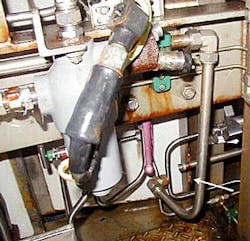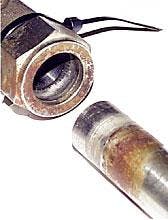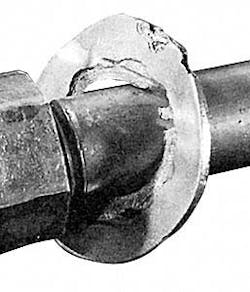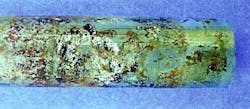A corrosion-related failure of a tube fitting on an offshore platform highlights a potential safety issue that could affect thousands of fittings currently in service worldwide.
Corrosion is not a hidden menace. Its onset in fittings typically shows up as rust staining at the back of the nut. One usually can identify and correct it easily if appropriate monitoring procedures are in place.
Personnel need to monitor fittings routinely, at least annually. Evidence of corrosion demands that the fitting in question be inspected internally and replaced if necessary.
An understanding of the key mechanism that causes tube fittings to corrode is crucial for building higher integrity systems for avoiding such problems.
North Sea failure
Failure on a North Sea platform occurred primarily as a result of corrosion on the gripping ferrule of an industry-standard twin-ferrule instrumentation tube fitting that had been in service for at least 12 years, and possibly as many as 17.
The fitting, in an enclosed equipment area, was in a high-pressure, 3,000 psi, hydraulic system that operated valves and subsea equipment on the oil and gas production platform. The failure resulted in a technician being hit by high-pressure hydraulic fluid.
The operating company undertook a detailed inquiry into the causes of the event and asked Parker Instrumentation, a division of Parker Hannifin Corp., Cleveland, Ohio, to analyze the failed joint and survey the platform for early indications of any similar corrosion problems.
The failure was in a 3/4-in. elbow tube fitting at the end of a 14-gauge, 0.080-in. WT, 12-in. long stainless-steel tubing run that appeared to have been assembled correctly (Figs. 1 and 2). The 3,000-psi operating pressure was well within the range of such a compression joint.
The analysis found that the primary cause of the failure was corrosion to the back ferrule (Fig. 3). The nitride hardening of the ferrule led to the failure, although the likelihood of failure increased almost certainly because of a recent installation of an inadequately supported heavy pressure switch in the tubing run.
Although Parker, the fitting manufacturer, considered nitride hardening as the best ferrule hardening technology at the time of the fitting's manufacturing (up to 1986), field experience during the 1980s showed this form of hardening contributed to corrosion problems. Since then, Parker and some other manufacturers have developed alternative hardening processes.
Nevertheless, some fitting manufacturers still use the same or similar case hardening technology today, as well as other processes that have similar problems with corrosion.
Corrosion-prone
The twin-ferrule fittings used by most industrial organizations and almost all oil and gas companies rely on compression to make a seal. For sizes greater than 1/4 in. (6 mm) to grip, the back ferrule bites into the tube. To do this effectively, the ferrule must be harder than the tubing material, which is typically 316 stainless steel.
A common user misunderstanding is that the material in a ferrule, which grips the tube, is made from the identical material as the overall fitting. In fact, a successful joint requires a ferrule harder than the tube.
For the ferrule part of the tube fitting, manufacturers have used stainless steel that is hardened by various processes to protect it in aggressive environments. Common methods include work hardening, chrome plating, and case hardening by chemical treatment. Also some fitting manufacturers do not harden any ferrules or only harden selected sizes.
Each approach has a weakness that opens up a path for corrosion, and the problem can be exacerbated by such factors as remaking joints, juxtaposition of materials used in the installation, and local environmental conditions.
Work hardening relies on the drawing effect when the steel is produced to create a hard outer skin. When machined, the process removes skin, thus reducing the hardness.
Highly worked austenitic material becomes susceptible to stress corrosion and particularly liable to sulfide stress corrosion. During fitting make-up and assembly, this susceptibility can result in deformation in the nose area of ferrule.
Chromium plating results in a very hard surface, but adhesion of it to stainless steel and accurate control of thickness are difficult. When the joint is made, this surface is susceptible to cracking or plate separation because of high load and rotational rubbing forces.
Case hardening, such as nitriding or carbonizing, is a common method of infusing hardness over a selected area. The method increases the carbon level in the surface area and ensures a correct and consistent level of hardness. But the process changes the structure of austenitic stainless steel, pulling carbon from within to the biting edge, and therefore effectively transforming adjacent material into mild steel that is susceptible much more to corrosion.
The "Types of Corrosion" box illustrates how corrosion affects ferrules with hardening treatments that are not corrosion resistant.
Other factors
The salt spray in an offshore environment accelerates the corrosion process, and in the case of the North Sea offshore platform, the fitting's location in an enclosed room may have further accelerated damage.
In Parker's experience, fitting corrosion in offshore environments tends not to start in areas directly exposed to saline spray but in areas that are semiprotected or internal, such as pump and compressor rooms. This is particularly the case in facilities subject to wide temperature fluctuations, such as in the Middle East or the Gulf of Mexico.
In this environment, evaporation concentrates salts and chlorides, and subsequent condensation causes the fluids to drip onto equipment. Tubing is a particular problem because fluid tends to follow the tubing runs until it becomes trapped in crevices and spaces formed by clamps and fittings.
Galvanic reactions further intensify corrosion because of tiny electrical cells formed by the metal and the surrounding environment. In the fitting failure case, juxtaposition of mild and stainless steels with concentrated saline solutions acting as an electrolyte created the electrical cell.
Different metals have different chemical reactivity potentials and levels of resistance to corrosion. Noble metals such as gold are at one end of the scale, while active materials such as potassium are at the other. The farther apart the materials are on the scale, the greater the current flow and the faster the corrosion.
Metals close to the noble end of the scale act as the cathode of the cell and are protected. The metal closer to the reactive end of the scale acts as the anode and corrodes.
Equipment designers use galvanic series tables (see "Galvanic Series" box) to avoid problematic clashes by choosing materials with a lower potential difference.
Risk reduction
Reducing the risk of corrosion requires one to select appropriate materials for the application, good maintenance procedures, and close attention to the ferrule hardening techniques employed.
Recognition of the importance of suitable ferrule treatment hardening techniques has driven companies to research alternatives to conventional hardening options, with their associated drawbacks. Parker, for example, adopted a proprietary form of chemical hardening that penetrates only few microns.
Parker introduced this treatment process, called Suparcase, in 1986. It has the advantage of not changing the underlying molecular structure of the stainless steel. This treatment maintains the intrinsic spring quality of the stainless steel and allows joints to be remade.
The oil and gas sector has tended to lag other industrial users in ferrule specifications. The chemical industry, for example, has become aware of the need for ferrule specification during the past decade. But many oil and gas companies continue to specify just a type of fitting and material.
Oil and gas operators do, however, lead the field in the specification and use of exotic materials to optimize corrosion protection.
A few fittings manufacturers now offer a wide selection of specialized materials that mostly were developed for specific oil and gas projects. The "Exotic Materials" box summarizes key attributes of commonly available exotic materials.
Types of corrosion
Some examples of what corrosion can do to ferrules with hardening treatments that are not corrosion resistant, such as nitride hardening, are as follows: Crevice and surface deposits can result in different concentrations of dissolved matter, such as metal ions, leading to accelerated local corrosion as shown in this stainless steel tubing (see photo 1).
Pitting corrosion causes local penetration, normally at many different sites. The metal between the pits is relatively unaffected, although pits may become connected as attack progresses. The photo 2 shows a stainless steel tube with extreme surface pitting.
Stress corrosion cracking causes cracks to form in an alloy under tensile stress in the presence of specific corrosives. It occurs at stresses less than the tensile strength of the alloys and has the appearance of brittle fracture, even in normally ductile materials (photo 3).
Galvanic series
Vulnerable end (anodic, least noble)
Magnesium
Magnesium alloys
Zinc
Galvanized steel or galvanized wrought iron
Aluminum (5052, 3004, 3003, 1100, 6053, in order)
Cadmium
Aluminum (2117, 2017, 2024, in order)
Mild steel
Wrought iron
Cast iron
410 stainless steel (active)
50-50 lead-tin soldier
304 stainless steel (active)
316 stainless steel (active)
Lead
Tin
Muntz metal
Manganese bronze
Naval brass
Nickel 200 (active)
Inconel alloy 600 (active)
Yellow brass
Admiralty brass
Aluminum bronze
Red brass
Copper
Silicon bronze
70-30 Copper-Nickel
Comp. G-Bronze
Comp. M-bronze
Nickel 200 (passive)
Inconel alloy 600 (passive)
Monel alloy 400
304 stainless steel (passive)
316 stainless steel (passive)
Inconel alloy 825
Inconel alloy 625
Hastelloy alloy C
Titanium
Protected end (cathodic, most noble)
Exotic material
To prevent corrosion, the industry can use various exotic materials such as 6Mo, Alloy 400, Alloy 600, Alloy 825, Alloy C276, and Titanium.
6Mo
6Mo is an austenitic stainless steel that, because of its relatively high molybdenum content, possesses very good resistance to pitting and crevice corrosion. It was developed for use in halide-containing environments prone to crevice, pitting, and stress corrosion attacks.
It is especially suited to handle high-chloride environments such as brackish water, seawater, caustic chlorides, and pulp bleach systems.
Microbially influenced corrosion (MIC) can occur in brackish and waste-water systems especially where equipment has been idle for extended periods. 6Mo is extremely resistant to MIC and for this reason, it also is used where bacteria and algae form biofilms on metal surfaces, such as in warm seawater areas of the Middle East or the Gulf of Mexico.
Alloy 400
Alloy 400 is the first nickel alloy invented and one of the most extensively used because of its excellent corrosion resistance to a wide range of media. It also has outstanding resistance to neutral and alkaline salts and is a standard material for salt plants. It shows very high resistance to caustic alkalis.
Its behavior in seawater is excellent, with improved resistance to cavitation corrosion compared with other copper-based alloys. Alloy 400 can be used with dilute solutions of mineral acids, such as sulfuric and hydrochloric.
One should note that because the alloy contains no chromium, oxidizing conditions can increase corrosion rates.
While it can be considered immune to chloride-ion stress cracking, it can stress crack in the presence of mercury or in most aerated hydrogen-fluoride vapors.
Alloy 625
Alloy 625 is a low-carbon, nickel-chromium-molybdenum-niobium alloy showing excellent resistance to a variety of corrosive media. It has outstanding resistance to pitting and crevice corrosion as well as good resistance to intergranular attack.
The alloy also has almost total resistance from chloride-induced stress corrosion cracking.
Because of these properties, the alloy has extremely high resistance to attack by a wide range of media and environments including nitric, phosphoric, sulfuric and hydrochloric acids, as well as alkalis and organic acids in both oxidizing and reducing conditions.
The alloy has virtually no corrosive attack in marine and industrial atmospheres with extremely good resistance to seawater, even at elevated temperatures.
Alloy 825
Alloy 825 is a titanium-stabilized fully austenitic nickel-iron-chromium alloy with additions of copper and molybdenum. This alloy is characterized by its good resistance to stress corrosion cracking and to oxidizing and non-oxidizing hot acids alike. It also has a very satisfactory resistance to pitting and crevice corrosion.
The alloy is a versatile general engineering alloy with good resistance to corrosion in a wide range of media such as sulfuric, sulfurous, phosphoric, nitric and organic acids, alkalis such as sodium or potassium hydroxide, and aqueous chloride solutions.
Its high nickel content gives this alloy almost complete immunity to stress corrosion cracking.
Alloy C276
Alloy C276 is a nickel-molybdenum-chromium wrought alloy, generally considered to be the most versatile corrosion resistant alloy currently available. It has outstanding resistance to localized corrosion and to both oxidizing and reducing media.
The alloy has very good resistance to a wide range of chemical process environments, including strong oxidizers such as ferric and cupric chlorides, hot contaminated media, chlorine, a variety of acids, and seawater and brine solutions.
It is one of the few materials that can withstand the corrosive effects of wet chlorine gas, hypochlorite, and chlorine dioxide.
The alloy is a favorite with chemical plants because of its excellent mechanical properties. This gives it good durability in addition to its resistance to aggressive process fluids.
Titanium
Titanium is a superior and a very reliable material in a wide range of chemical, industrial, marine, and aerospace applications.
The material is immune to chloride pitting and intergranular attack and is highly resistant to crevice and stress corrosion.
Titanium and its alloys have unique properties that make them a good choice even when strength or corrosion resistance may not be critical. These include low density, high melting point, nonmagnetic, an extremely short radioactive half life, and very low modulus of elasticity and co-efficient of expansion.
These factors allow the material to be very flexible while giving extremely high-strength properties with a reduced weight ratio.
The author
Steve Mullen is European tube fittings product manager for Parker Instrumentation, based in Barnstaple, England. He has worked for the company in a number of roles including process planning, and production engineering.









